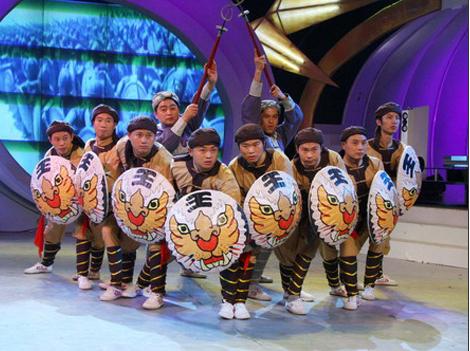
Shield dance,also known as men's rattan shield dance or rolling and blocking shield,has been spread in towns like Longyuankou and Yan'ge in south Yongxin County of Jiangxi Province.The saying that"If you do not practice shield dance,you will not be qualified to be a real man"has been handed down until now in Nantang Village of Longkou Town.Shield dance integrates martial arts,acrobatics,dance and music,and its movements are robust,vigorous and tough.It has plenty of strange arrays which look odd and magnificent,and it is full of strong combative power and ethnic characteristic.
Shield dance originates from shield tactics in ancient army.It is said that the chapter"Outline of Rattan Shield"in New Book on Military Training(Jixiao Xinshu)written by the famous general Qi Jiguang in the Ming Dynasty is regarded as the source of the shield dance.So far there has yet no final conclusion on the time when the shield dance was introduced to Jiangxi.One version holds that the people who moved from the Yellow River valley in large-scale brought the shield dance to Jiangxi.Another saying deems that the dance originates from the shield martial arts created by the noted general Huang Gai in the Three Kingdoms Period.And still there are some regarding that the shield dance originates from the Qing Dynasty when the Taiping Heavenly Kingdom Movement failed,some officers and soldiers of the Taiping Troops fled to this area and created a method to practice the shield dance to build their bodies and resist the foes effectively.
Shield dance has a set of traditional,solemn and stirring form of performance.The movement of shield is slight but its frequency is very quick,and during the performance the actors should pay much attention to eight characters:"push,block,hang,support,compel,dodge,fall and roll".Before the performance the dancers must hold a solemn ceremony:led by the patriarch,the dancers should kill roosters to make sacrifice to their ancestors,with the purpose of"Praying for the peace of the men who are going out for a battle,which is obviously a ritual left behind by the ancients.
All of the nine actors wear long head scarves,short black double-breasted blouses that are edged with white and have decorative design on the bosom on their upper bodies,black tightened opening-trouses,leg wrappings as well as Jute sandals.The actor who holds a steel fork with small rings plays the role of the officer or the adversary cavalryman,while the others hold a shield in one hand and a sword in the other hand;all of them are valiant and powerful.There are many kinds of shield shapes,such as round,ellipse,swallowtail,rectangular and so on.Most of the designs on the shield surface are animal heads.Owing to the local geographic advantages,most of the shields are made from bamboo and rattan,and they become considerably firmer after being covered with animal skin.
The plot of the shield dance is quite simple:it simulates the counterwork and fighting between two troops as well as the alternate attack and defending of each other.However,there are too many kinds of battle arrays which will confuse the audience.The whole performance consists of eight battle arrays:foursquare array,snake-team array,V-shape array,wasp array,portal shaped array,small bag array,dahuazhen array(picking flower array)and closing array.The music of the shield dance is also of a unique style:the folk percussion instruments are always used in the performance,and when the actors are walking around the playground the drums of"fanjimao"are beat.In some places,string instruments and wind instruments are also added in the accompaniment,and in some other places a special instrument called"Nazi"is used,which can produce a sharp,high and penetrating sound.





